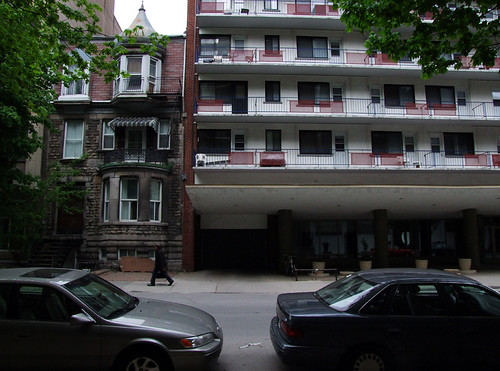
Hutchison Street in Milton Park, aka the McGill Ghetto
The neighbourhood of Milton-Parc is tucked into a corner of downtown between McGill University and the mountain. The area has been known for community engagement and co-operative housing projects that are home to some 1,500 of its 11,000 residents. Green space is scarce. After months of meetings and public forums the Urban Ecology Centre of Montreal has published a sustainability plan for the neighbourhood.
MUEC coordinator Luc Rabouin told the Montreal Mirror they’re “implementing helpful changes, like creating community compost bins and giving priority to pedestrians and cyclists on certain streets during specific times of the day.” The MUEC emphasizes community input and involvement. Citizens who are interested can check out the sustainability plan online. The plan focuses looks at themes including water conservation, energy consumption, waste management, transportation and the interconnectedness of humans and nature. Here’s a summary:
TRANSPORTATION: In terms of transportation they want to widen sidewalks, install more bike racks and improve bike lanes to encourage more active transportation. They want to set up bike-share and car-share programs and work with the Montreal police to prevent bike theft.
WASTE: The province is committed to reducing waste by 60 per cent by 2008, but as the city has been slow-moving in reaching this goal, individual areas are taking the matter into their own hands. Pointe-Claire and Cote-St-Luc have undertaken curbside compost pickup. In the Milton-Parc sustainability plan, reducing landfill waste to zero is the ultimate goal. A waste audit – rummaging through the trash –will help determine the needs of the community and to track progress. Community composting is part of the project, as is the establishment of a “tool lending library” and workshops on reusing and recycling materials like wood and cloth. To make it easier to deal with large waste like old appliances, they want to set up a drop-off point in the neighbourhood as well as a second-hand store for used household goods.
ENERGY: To reduce energy some of the ideas include financial or tax incentives for business, retrofitting older buildings and experimentation with “small-scale, decentralized and renewable energy projects (wind, sun and biomass).”
WATER: Rainwater collection, grey-water re-use and green rooftops are some of the proposed pilot projects. Larger projects include opening streams that used to run through the neighbourhood in a “physical, visual or symbolic sense.” Reducing water use in the home is also a priority.

6 comments
Great article!
Little quibble about toponymy: the neighborhood’s never been known as “Milton Park”. The city’s hyphenated name for the neighborhood comes from its central intersection of Milton and avenue du Parc (never Park).
French hyphenation rules for place names can be a bit confusing, but trust me — as a lifelong resident of Montreal, it’s never been known as anything but “the McGill Ghetto” since about the 1950s, and before that it was simply part of the Golden Square Mile, the wealthiest residential neighborhood in the British Empire outside of London!
Officially, the neighbourhood is known as Milton-Parc, which is often translated as Milton-Park in English. The Urban Ecology Centre is known to use both spellings.
Still, I prefer the McGill Ghetto because Milton-Park seems like such a contrivance.
Still, either way, it’s a hyphenated name indicating a conjunction and not a place name per se. It’s not like Oak Park, Wicker Park or Stanley Park, it’s the intersection of Milton Street and Park Avenue. A better way of writing this might be “Milton/Park,” actually.
I mean it would be like me writing about the the York Dale (which would be next to the York Hill, I guess) for Spacing Toronto…. :)
Thanks for the comments aj. I thought about this briefly when I was writing it up, but settled on Milton-Parc because that’s what the Urban Ecology Centre used in their document. Parc with a “c” because of the road and I don’t like to anglicize street names.
According to the Grand répertoire du patrimoine bâti de Montréal, the Milton-Park neighbourhood is also known as “Mont Sainte-Famille”. See http://patrimoine.ville.montreal.qc.ca/inventaire/fiche_zone.php?arrondissement=2&batiment=oui&lignes=25&protection=0&zone=&id=1087.
I believe aj is mistaken in saying “the neighborhood’s never been known as “Milton Park””. The name’s been in common usage since at least the 1970’s up to the present day. As for the Golden Square Mile, isn’t that only west, and not east, of the McGill campus?
Park with a “k” because (a) that was the original name, (b) it reflects local anglophone usage and (c) what’s wrong with anglicizing street names?
Great post, i like the way you say it :)